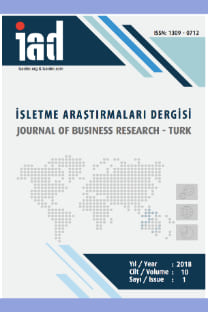Türkiye Ekonomisinde Güven-Hisse Senedi Getiri İlişkisi
Confidence–Stock Yield Relation in Turkish Economy
___
- Akhtar, S., Faff R., & Oliver B. (2010). The Power of Bad: The Negativity Bias in Australian Consumer Sentiment Announcements on Stock Returns. Journal of Banking & Finance, 35, 1239–1249.
- Awokuse, T. O. (2003). Is the Export-Led Growth Hypothesis Valid For Canada? Canadian Journal of Economics, 36(1), 126-136.
- Ayuningtyas, R., & Koesrindartoto, D. P. (2014). The Relationship between Business Confidence, Consumer Confidence, and Indexes Return: Empirical Evidence in Indonesia Stock Exchange. International Conference on Trends in Economics, Humanities and Management, 21-25.
- Baker, M., & Wurgler, J. (2007). Investor Sentiment in the Stock Market. Journal of Economic Perspectives, 21(2), 129-152.
- Bathia, D., & Bredin, D. (2013). An Examination of Investor Sentiment Effect on G7 Stock Market Returns. European Journal of Finance, 19(9), 909–937.
- Baumohl, B. (2012). The Secrets of Economic Indicators: Hidden Clues to Future Economic Trends and Investment Opportunities. New Jersey: FT Press.
- Brown, R. L., Durbin J., & Evans J. M. (1975). Techniques For Testing The Constancy of Regression Relations Overtime. Journal of the Royal Statistical Society, 37(13), 149-163.
- Chen, S. S. (2011). Lack of Consumer Confidence and Stock Returns. Journal of Empirical Finance, 18, 225–236.
- Collins, D. (2001). The Relationship between Business Confidence Surveys and Stock Market Performance. Investment Analysts Journal, 54, 9-17.
- Dickey, D. A., & Fuller, W. A. (1981). Likelihood Ratio Statistics for Autoregressive Time Series with a Unit Root. Econometrica, 49(4), 1057-1072.
- Eyüpoğlu, K., & Eyüpoğlu, S. (2017). Ekonomik Güven Endeksi İle Hisse Senedi Fiyatları Arasındaki İlişkinin İncelenmesi: Türkiye Örneği. Gazi Üniversitesi İktisadi ve İdari Bilimler Fakültesi Dergisi, 19(2), 603-614.
- Ferrer, E., Salaber, J., & Zalewska, A. (2014). Consumer Confidence Indices and Stock Markets Meltdowns. The European Journal of Finance, 22(3), 195-220.
- Fisher, K.L., & Meir, S. (2003). Consumer Confidence and Stock Returns. Journal of Portfolio Management, 30, 115-12.
- Gujarati, D. N. (1995). Basic Econometrics. USA: MC-Graw-Hill.
- Hsu, C-C., Lin, H-Y., & Wu, J-Y. (2011). Consumer Confidence and Stock Markets: The Panel Causality Evidence. International Journal of Economics and Finance, 3(6), 91-98.
- Jansen, J. W., & Nahius, J. N. (2002). The Stock Market and Consumer Confidence: European Evidence. Economics Letters, 79, 89-98.
- Kandır, S. Y. (2006). Tüketici Güveni ve Hisse Senedi Getirileri İlişkisi: İMKB Mali Sektör Şirketleri Üzerinde Bir Uygulama. Çukurova Üniversitesi Sosyal Bilimler Dergisi, 15, 217-230.
- Korkmaz, T., & Çevik, E. İ. (2009). Reel Kesim Güven Endeksi ile İMKB 100 Endeksi Arasındaki Dinamik Nedensellik İlişkisi. İstanbul Üniversitesi İşletme Fakültesi Dergisi, 38, 24-37.
- Köse, A., & Akkaya, M. (2016). Beklenti ve Güven Anketlerinin Finansal Piyasalara Etkisi: BIST 100 Üzerine Bir Uygulama. Bankacılık Dergisi, 99, 3-15.
- Mavrotas, G., & Kelly, R. (2001). Old Wine In New Bottle: Testing Causality Between Savings And Growth. The Manchester School Supplement, 97–105.
- Ottoo, M. W. (1999). Consumer Sentiment and Stock Market. Finance and Economics Dicussion Series from Board of Governors of Federal Reserve System. https://www.federalreserve.gov/pubs/feds/1999/199960/199960pap.pdf (25.10.2017).
- Pesaran, M. H., & Shin, Y. (1995). Autoregressive Distributed Lag Modelling Approach to Cointegration Analysis. University of Cambridge DAE Working Paper Series, 9514, 1-33.
- Pesaran, M. H., & Pesaran, B. (1997). Working with Microfit 4.0, Interactive Econometric Analysis. Oxford: Oxford University Press.
- Pesaran, M. H, Shin, Y., & Smith, R. J. (2001). Bounds Testing Approaches to the Analysis of Level Relationships. Journal of Applied Econometrics, 16(3), 289- 326.
- Salhin, A., Sherif, M., & Jones, E. (2016). Managerial Sentiment, Consumer Confidence and Sector Returns. International Review of Financial Analysis, 47, 24-38.
- Schmeling, M. (2009). Investor Sentiment and Stock Returns: Some International Evidence. Journal of Empirical Finance, 16, 394–408.
- Topuz, Y. V. (2011). Tüketici Güveni ve Hisse Senedi Fiyatları Arasındaki Nedensellik İlişkisi: Türkiye Örneği. Ekonomik ve Sosyal Araştırmalar Dergisi, 7(1), 53-65.
- Uygur, U., & Taş, O. (2014). The Impacts of Investor Sentiment on Returns and Conditional Volatility of International Stock Markets. Quality and Quantity, 48(3), 1165–1179.
- Vogelvang, B. (2005), Econometrics Theory and Applications with Eviews. England: Prentice Hall.
- ISSN: 1309-0712
- Yayın Aralığı: 4
- Başlangıç: 2009
- Yayıncı: Melih Topaloğlu
Parasal Sistemde Altının Yeri ve Altına Dayalı Finansal Araçlar
Gültekin RODOPLU, BİLGE LEYLİ ELİTAŞ
Örgütsel Yaşamda Kişilik ve Performans İlişkisinde Pozitif Duygusallığın Aracı Rolü
Karizmatik Liderlik ve Örgütsel Özdeşleşmenin İş tatmini ve İşten Ayrılma Niyetine Etkisi
Ayşe Alev YAVAN, ALPTEKİN SÖKMEN, Yunus BIYIK
Evaluation of Customer Loyalty Implementations By Consumers
Türkiye Ekonomisinde Güven-Hisse Senedi Getiri İlişkisi
N. Serap VURUR, HURİYE GONCA DİLER
BİST Endeksleri ile Kurumsal Yönetim Endeksi Arasındaki Volatilite İlişkisinin İncelenmesi
ÖMER FARUK GÜLEÇ, RAİF CERGİBOZAN
Akreditif Teyit Sigortası’nın Türk Finansal Kesiminde Uygulanması ve Muhtemel Etkileri
